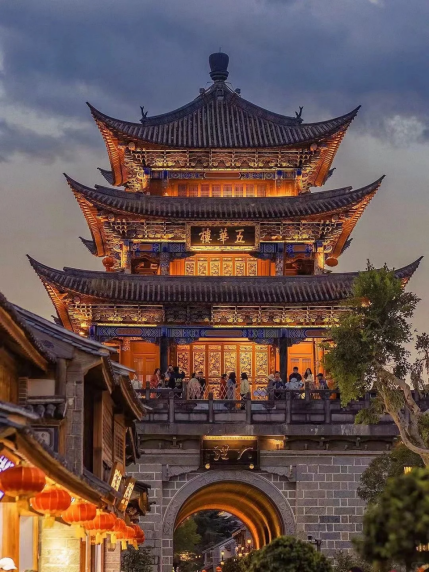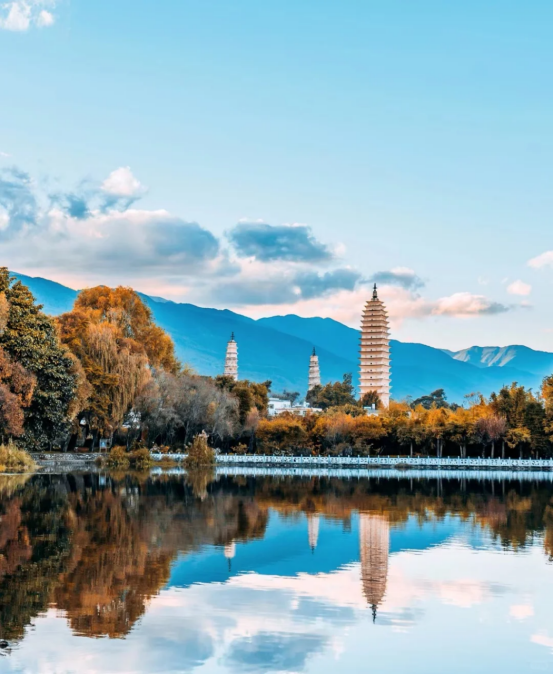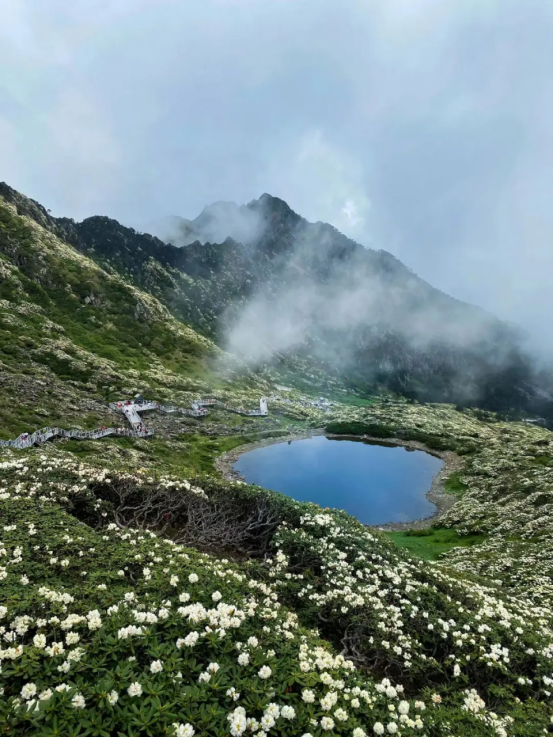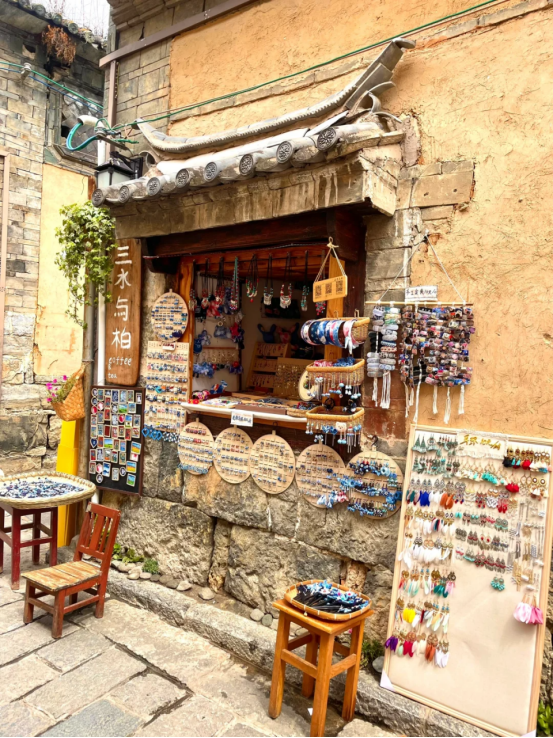Dali, located in western Yunnan Province, China, lies between the majestic Cangshan Mountains and the serene Erhai Lake. Blessed with a mild, spring-like climate year-round, it offers breathtaking natural beauty and a rich cultural heritage. This picturesque land is the heart of Bai culture, known for its vibrant traditions and long history. Dali is often celebrated as the embodiment of "wind, flowers, snow, and moon"—symbols of poetic romance and elegance—while the phrase "Dali in March is a delightful sight" vividly captures its enchanting charm.
Once the ancient capital of the Nanzhao and Dali Kingdoms, the city preserves the essence of its historic past while also serving as a modern haven for relaxation. Visitors are drawn to its timeless allure, wandering between Cangshan’s peaks and Erhai’s shores, in search of a life filled with natural beauty and poetic inspiration.
I. The Ancient Charm of Dali
Dali is a city rich in cultural heritage, once serving as the capital of the Nanzhao Kingdom and the Dali Kingdom. Every stone and tile in this ancient town carries the whispers of history.

Dali Old Town is home to many traditional Bai-style buildings, with winding stone-paved streets and whitewashed walls topped with gray-tiled roofs, creating a unique ethnic charm. The town is filled with bustling shops offering handmade crafts and local delicacies. Cozy tea houses and book cafés are scattered throughout, inviting visitors to relax and enjoy the slow pace of life. This blend of historical depth and modern serenity makes it an ideal place to explore Dali’s culture.
The Three Pagodas of Chongsheng Temple, one of Dali’s most iconic landmarks, stand majestically between Cangshan Mountain and Erhai Lake. The central pagoda, flanked by two smaller ones, is a magnificent sight. As a thousand-year-old Buddhist site, it bears witness to the flourishing of Buddhism and draws countless visitors seeking spiritual connection and breathtaking views.

Nearby, the Nanzhao Kingdom ruins offer a glimpse into the region’s past glory. Artifacts unearthed here reveal the prosperity and cultural richness of the ancient kingdom, allowing visitors to better understand Dali’s significant role in Chinese history. A walk through these historic sites is a journey into the heart of Dali’s vibrant past.
II. A Hidden Paradise Among Mountains and Water
Erhai Lake, one of Dali’s most famous landmarks, sparkles under the sun, surrounded by picturesque countryside and charming villages, creating a serene, fairy-tale-like setting. Cycling along the lakeshore is one of the best ways to experience its beauty. The route offers views of traditional Bai villages, rows of wind turbines, and willow trees lining the water’s edge, with a gentle breeze adding to the tranquility. Taking a boat ride provides another perspective of Erhai’s charm, especially during sunrise or sunset when the scenery transforms into a living painting.

Towering over Dali, Cangshan Mountain serves as a majestic natural barrier to Erhai Lake. Its cloud-shrouded peaks and lush greenery create a breathtaking backdrop. Adventurers can hike or take a cable car to explore its grandeur. Mountain streams and waterfalls cascade down its slopes, and the Jade Belt Cloud Path, a scenic trail winding across the mountainside, offers panoramic views of both Erhai and the surrounding landscape, making it an unforgettable journey.

Xizhou Ancient Town, located northwest of Erhai, is a historic Bai village rich in culture and tradition. Its well-preserved architecture features classic Bai-style houses, surrounded by fields and farmhouses that reflect the harmony between humans and nature. Visitors can wander through the ancient streets, immerse themselves in a tranquil rural atmosphere, and savor the famous Xizhou Baba, a flaky, flavorful local pastry that adds a delicious touch to the experience.

Dali’s enchanting landscapes of mountains and water blend seamlessly to create a paradise away from the world. Whether at Erhai, Cangshan, or Xizhou, the serene beauty of this region offers peace and wonder, inviting visitors to bask in its timeless charm.
III. Echoes of the Ancient Tea Horse Road
Dali’s tea culture, rooted deeply in its history and daily life, is best represented by Pu’er tea and Bai ethnic Three-Course Tea, reflecting the region’s unique charm and ceremonial traditions.
Pu’er tea is celebrated for its rich heritage and unique fermentation process, making it an essential part of daily life for locals. The Bai people’s Three-Course Tea is a symbolic tea-drinking ritual known as a reflection on life. The first cup, “bitter tea,” represents the hardships of life; the second, “sweet tea,” symbolizes happiness; and the third, “aftertaste tea,” embodies reflection and wisdom, illustrating the Bai people’s philosophy of life through the art of tea.
The Tea Horse Road, a vital trade route connecting China’s inland with Tibet and beyond, holds centuries of history. As a key hub on this route, Dali was crucial for the transportation of Pu’er tea. Walking along the ancient path, one can almost hear the echo of bustling traders and feel the weight of history carried by generations of tea merchants. More than a trade route, it was a bridge of cultural exchange, connecting the Central Plains with southwestern ethnic communities.
Tea garden tours and hands-on tea-picking experiences offer a deeper connection to Pu’er tea’s origins. Visitors in Dali can pick fresh tea leaves and participate in the entire tea-making process—from withering, pan-firing, and rolling to drying—gaining a new appreciation for the craftsmanship involved. Sipping a cup of tea made by one’s own hands brings not only sensory pleasure but also a renewed respect for nature and hard work.
Dali’s tea culture blends rich history with the Bai people’s life philosophy. Whether observing ceremonial tea practices or engaging in the hands-on joy of tea production, visitors will discover the profound cultural charm that makes this ancient city so captivating.
IV. Culinary Delights of Dali
Dali’s food culture is rich and diverse, blending Bai ethnic traditions with the region’s abundant natural resources, making it an essential part of any visit.
Bai Sour and Spicy Fish and Rushan are two iconic dishes. Sour and Spicy Fish uses fresh fish from Erhai Lake, combined with pickled vegetables and a special mix of seasonings, creating a dish that is tender, tangy, and invigorating—a perfect reflection of the Bai people’s vibrant culinary style. Rushan, a unique Bai cheese shaped like a fan, has a slightly tangy taste and can be enjoyed on its own or used in dishes. Paired with sour and spicy fish, it offers a delightful contrast of flavors.
Dali Cold Chicken Rice Noodles are a street-food favorite. Made with hand-prepared rice noodles and shredded chicken, the dish is dressed in a local specialty sauce, delivering a refreshing yet complex taste. This simple dish is a staple for the Bai people and a must-try for visitors.
Erhai Lake Fish Banquet is a culinary highlight, showcasing a variety of fresh fish prepared using steaming, boiling, and grilling methods. Seasoned with unique local spices, these dishes retain the fresh, natural flavors of the fish while offering a distinctive regional twist.
From street snacks to elaborate feasts, Dali’s cuisine reflects the region’s natural beauty and cultural heritage. Sampling these dishes is more than a treat for the taste buds—it’s a journey into the heart of Dali’s rich and flavorful traditions.
V. Experience Bai Culture
The rich cultural heritage of Dali’s Bai people comes alive through traditional crafts and vibrant festivals. From hands-on workshops to festive celebrations, visitors can feel the warmth and creativity of the Bai community.
Bai Tie-Dye is a renowned traditional craft, celebrated for its signature blue-and-white patterns. Visitors can join workshops to create their own tie-dye fabric, learning every step from sketching designs and tying the cloth to dyeing and drying. Each finished piece is a unique work of art, making tie-dye a popular souvenir for those exploring Dali’s cultural roots.
San Yue Jie (Third Month Fair) is the largest ethnic market in the region and a major Bai cultural event. Originating in the Tang Dynasty, it combines trade, cultural exhibitions, and artistic performances. At the fair, visitors can browse local handicrafts, savor traditional delicacies, and enjoy folk music and dance, immersing themselves in the festive spirit of Bai life.
The Torch Festival is one of the Bai people's most exhilarating traditions, symbolizing blessings and prayers for prosperity. Villages are decorated with lanterns, and massive torches illuminate the night while people sing and dance around the flames. Tourists are welcome to participate, sharing in the joy and excitement of this dynamic celebration.
These cultural experiences are more than events—they are a glimpse into the heart of Bai life and the essence of Dali's charm. Embracing Bai traditions offers a deeper connection to this vibrant and welcoming land.
VI. Practical Travel Tips: A Thoughtful Guide
-
Best Time to Visit: The best seasons to visit Dali are spring and autumn. The weather is pleasant, and flowers bloom throughout the year, making it ideal for sightseeing and outdoor activities.
-
Transportation and Accommodation: Dali Ancient Town is easy to explore on foot or by bike. For a more authentic experience, consider staying in local guesthouses, where you can enjoy Bai culture and the warm hospitality of the people.
-
Things to Keep in Mind: Dali is located in a plateau area, so visitors should be mindful of the altitude and allow time to acclimate to avoid altitude sickness. It's also important to respect local customs and traditions, especially those related to Bai culture.
VII. The Poetry and Wanderlust of Dali
Dali is a city where natural landscapes blend perfectly with rich cultural heritage, offering the tranquility of Erhai Lake, the majesty of Cangshan Mountain, and the unique charm of the Bai ethnic group. Here, history and modernity intertwine, tea and cuisine coexist, and visitors can enjoy a relaxed travel experience in a peaceful atmosphere. Whether immersing oneself in the serene sunrise by the lake or exploring Bai traditions in the ancient city's alleys, Dali offers a unique sense of poetry and beauty. Come to Dali, savor life, and experience the tranquility and joy that this paradise brings.
